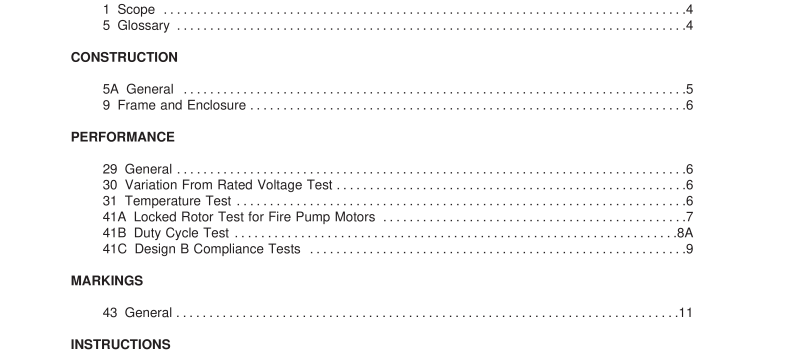UL 1004-5-2009 pdf download.Fire Pump Motors.
1 Scope 1 .1 This Standard is intended to be read together with the Standard for Rotating Electrical Machines – General Requirements, UL 1 004-1 . The numbering of the Sections in this Standard corresponds to the like numbered Sections in UL 1 004-1 . The numbering of the paragraphs are unique to this Standard, and do not directly correspond to the like numbered paragraphs in UL 1 004-1 . The requirements in this Standard supplement or amend the requirements in UL 1 004-1 . The requirements of UL 1 004-1 apply unless modified by this Standard. For Sections not shown, refer to the Standard for Rotating Electrical Machines – General Requirements, UL 1 004-1 . 1 .2 This Standard covers Design B polyphase motors, as defined in NEMA MG 1 , Motors and Generators, rated 500 horsepower (373 kW) or less, 600 volts or less, that are intended for use in accordance with NFPA 20, the Standard for the Installation of Centrifugal Fire Pumps. 1 .3 This Standard does not cover the fire pump controller. These controllers are covered by the Standard for Fire Pump Controllers, UL 21 8. 1 .4 These requirements do not cover motors intended for use in hazardous locations as defined in the National Electrical Code® , NFPA 70. The National Electrical Code® and NEC® are registered trademarks of the National Fire Protection Association, Inc., Quincy, MA 021 69. 5 Glossary 5.1 For the purpose of this Standard, the following definitions apply. 5.2 BREAKDOWN TORQUE – Maximum torque developed when a motor is run at rated voltage and frequency, without an abrupt loss in speed. 5.3 DESIGN B – A squirrel-cage motor designed to certain minimum torque values and a maximum locked-rotor current with a slip of less than 5 percent at rated load.
5.9 SLIP SPEED – The difference between the synchronous speed and the measured speed of a motor. 5.1 0 SLIP – Defined as Slip Speed divided by Synchronous Speed. 5.1 1 SYNCHRONOUS SPEED (of a motor) – Defined by the equation, η s = 1 20 × f / p in which: η s = the synchronous speed in revolutions per minute f = the line frequency in hertz p = the number of motor poles 5.1 2 TOTAL WEIGHT (FORCE) MOMENT OF INERTIA – The total weight moment of inertia is a measure of the distribution of the weight of an object relative to a given axis. The total weight moment of inertia is the product of weight times the radius of gyration. The total weight moment of inertia, “I”, is the expressed in units of distance squared times weight (or mass), i.e., kg·m 2 or lb·ft 2 . In the case of a fire pump, it is a characteristic of the pump which will dictate the amount of time, “t”, that it will take a motor with a torque, “T”, to accelerate the pump to a given speed. Conversely, it is a characteristic that will dictate the amount of time that a given pump, coupled to a given motor, will take to decelerate to a stop. CONSTRUCTION 5A General 5A.1 A motor for use with fire pumps shall be polyphase Design B, as defined in NEMA MG 1 , Motors and Generators. 5A.2 Fire pump motors intended for use with variable speed drives shall additionally meet the requirements of NEMA MG-1 , Motors and Generators, Part 31 , Definite Purpose Inverter Fed Polyphase Motors.
9 Frame and Enclosure 9.1 A fire pump motor enclosure shall be rated a minimum of Type 2, Dripproof, or shall be provided with the instructions specified in 45.1 to indicate a Type designation required for the use environment. The Type designation shall be in accordance with the Standard for Enclosures for Electrical Equipment, UL 50. PERFORMANCE 29 General 29.1 The voltage of the test circuit for the performance tests shall be at rated voltage unless stated otherwise in the individual tests. 29.2 The tests are capable of being conducted in any order, as long as the Dielectric Voltage-Withstand Test, Section 36 of UL 1 004-1 , is conducted on a motor in a heated condition. 29.3 When a single motor sample is used for several or all tests, only one Dielectric Voltage-Withstand Test, Section 36 of UL 1 004-1 , shall be performed on the sample. It shall be performed after all other tests for that sample have been completed and the motor sample is in a heated condition. When a single motor sample is used for each test, the Dielectric Voltage-Withstand Test, Section 36 of UL 1 004-1 , shall be performed as required on each sample.UL 1004-5-2009 pdf download.
UL 1004-5-2009 pdf download
